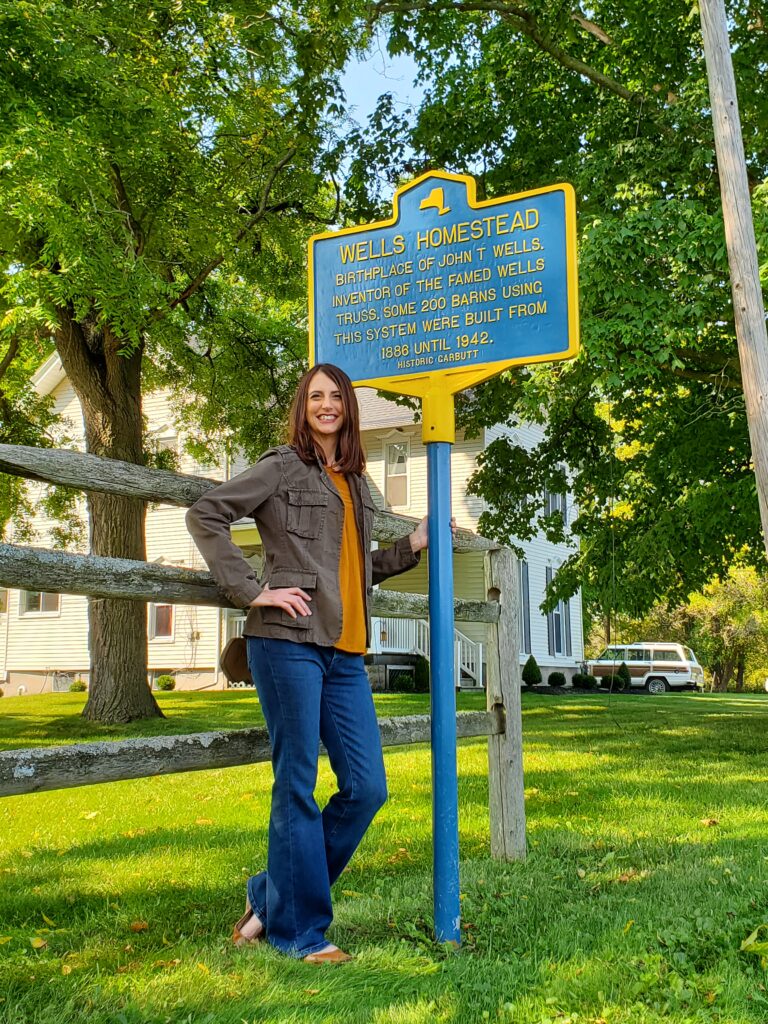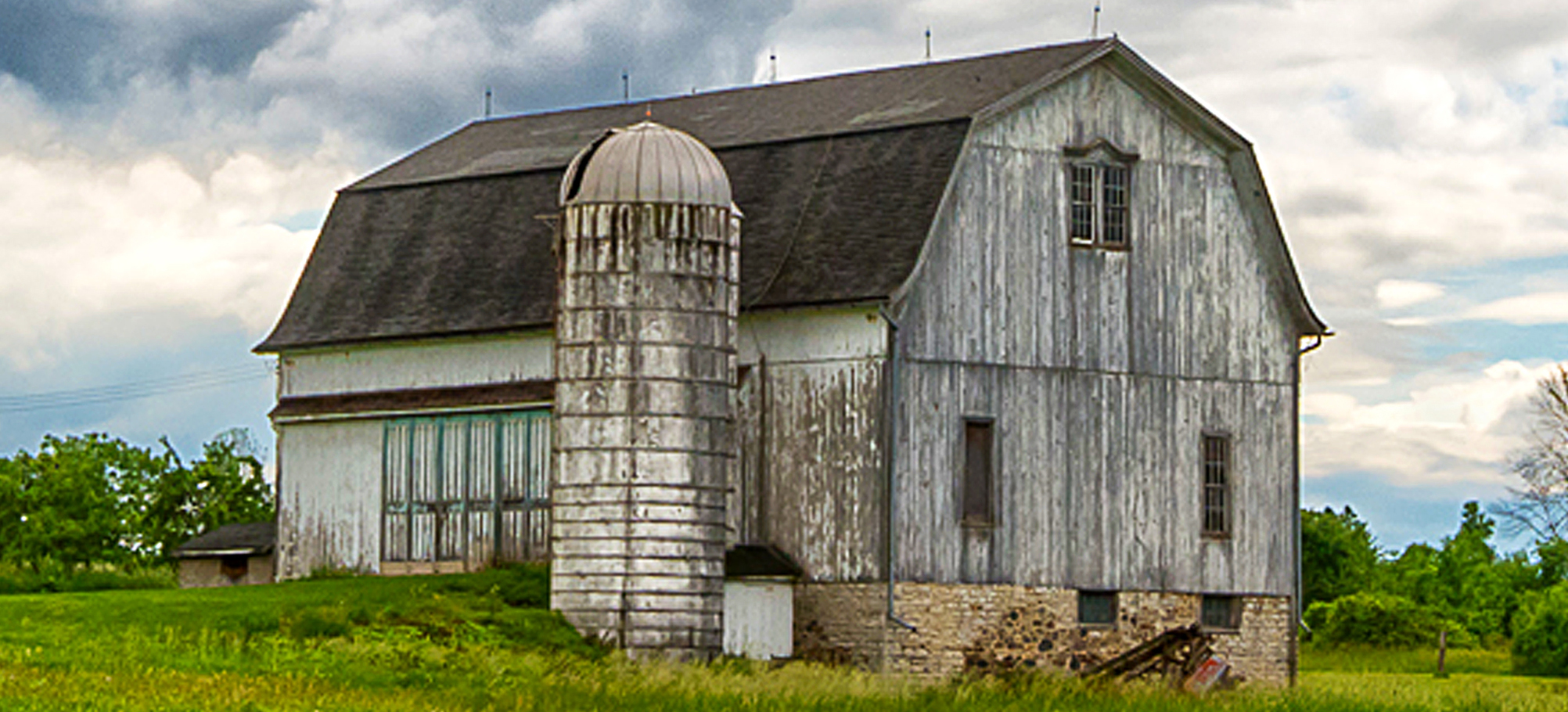Still Standing: The Barns of J.T. Wells & Sons, a new documentary produced by Katie Andres and Jill Kuchman of Churchbell Creative, LLC., highlights the history, heritage, and present-day plight of Western New York’s agriculturally and architecturally significant Wells barns. The 90-minute film makes its television debut on WXXI-TV on Monday, May 13 at 9 p.m. and encores Sunday, May 19 at 2:30 p.m.
We asked co-producer Katie a few questions about the film and here’s what she had to say.
Q. What inspired you to produce a documentary specifically focused on Wells barns?
While working at the Avon Century Barn in 2015, guests peppered me with questions related to the barn’s history and design. My limited knowledge about the structure wasn’t enough to satisfy the curiosity of the guests – or my own!
I turned to the Monroe County Library System in desperation. Typing “Wells Barns” into the search box revealed a single title: Wells Barns: J.T. Wells & Sons, Scottsville, NY 1886-1942: Barns Still Standing. Locating this book at the Scottsville Free Library was a game-changer. Type-written by the wife of a Wells descendant, and featuring black and white photos, the book was a relic – and a researcher’s dream come true. This documentary is an extension of that original work – bringing barn lovers up to speed on the current status of Western New York’s Wells barns.

Q. How did you decide which Wells barns to feature in your documentary?
A. Meeting most viewers where they are in terms of their understanding of what a barn is and how it was originally used was strategic. The first profiled barn needed to be a barn still used for agricultural purposes. Nathan and Hannah Ruekberg’s barn was the perfect fit. In the same family for multiple generations, their barn represents a conundrum for the family and the documentary’s viewers – how will the decisions of the family’s sixth and seventh generations impact the barn’s future?
From there, we encourage viewers to “see” barns differently, presenting several adaptive reuse scenarios – culminating in the colossal undertaking of not only giving a barn a new purpose, but ultimately a new home in a new location.
Q. Did you encounter any challenges during the production phase, and how did you overcome them?
A. Over the past nine years we encountered many challenges. Funding its production was tough. The Wheatland Historical Association’s fiscal sponsorship of our production company greatly expanded our grant pool. Contributions from family members and friends and digging into our own pockets moved us forward. Filming during the height of the COVID-19 pandemic forced us to think creatively.
Q. How do you believe the documentary sheds light on the historical significance of Wells barns within the context of American agriculture?
A. Long ago, Wells barns were constructed with a clear purpose. They played an integral role in securing the harvest, protecting livestock, and housing farming equipment. Today, many of these barns have lost their original purpose and fallen into disrepair.
According to Frances Stern, former Manager of Technical & Grant Programs with the Preservation League of New York State, Wells barns were selected for inclusion on the League’s 2018-2019 “Seven to Save” Endangered Properties List with the intent that their example could provide a case study designed to raise awareness and to help inform and educate barn owners in NYS and across the country looking for support in re-purposing and re-envisioning other endangered barns and agricultural outbuildings.
Visually striking and arguably iconic, Wells barns are taken for granted by the average passerby. Yet beneath their soaring heights, their vast spaces are filled with stories. Rich in culture and history, they risk being silenced. As producers, we recognize the power of sharing these stories on-screen.
Q. Did you uncover any surprising stories while researching the history of these barns?
A. We have been spoiled with access to such a rich historical repository. Uncovering the history of other kinds of barns often proves much more difficult due to each structure’s unique vernacular architectural style. Documenting the history of houses usually took precedence over detailing the history of functional agricultural outbuildings.
Fortunately, Wells barns have had a series of champions – including Jean Melville, Daniel Fink, Bob and Judy Pratt, and others. The support of local historians and access to the Monroe County Library’s archives in conjunction with access to personal, family, and municipal archives was crucial.
Q. In what ways do you hope your documentary will contribute to preserving the legacy of Wells barns for future generations?
A. While several other states including Vermont, New Hampshire, Connecticut, Pennsylvania, Massachusetts, Michigan, Ohio, Indiana, and Washington State, have active and thriving barn preservation programs and associated financial and informational resources for barn owners considering preservation and adaptive reuse, people are taking a closer look at how New York State can provide additional support for barn owners.
In 2012, during a “Wells Barn Owner Meet-and-Greet” event co-sponsored by the Preservation League of New York State and the Wells Barn Legacy Team, Cynthia Howk, retired Architectural Research Coordinator for the Landmark Society of Western New York, urged the barn owners in attendance to advocate for an expanded and re-envisioned version of New York State’s own bygone Barn Restoration and Preservation Grant Program.
Since then, based on the combined efforts of State Senator Michelle Hinchey (SD-46) and Assemblymember Didi Barrett (AD-106), Governor Kathy Hochul signed the New York State Historic Barn Tax Credit into effect back in 2022. However, a series of qualifications currently exclude certain barn adaptive reuse scenarios – especially those costs involved with converting a historic barn into a primary residence.
With this television documentary, the producers of Still Standing: The Barns of J.T. Wells & Sons thrust one subset of New York State barns fully into the limelight, juxtaposing the importance of preserving these agriculturally and architecturally significant structures while leaving viewers questioning next steps for supporting barn owners currently shouldering our region’s collective history.
Q. What was the most rewarding aspect of producing this documentary for you personally?
A. Working together over the past nine years to further champion the stories of barn owners alongside my best friend has been an indescribable and humbling experience. Being able to rely on her technical expertise, experience, and artistry when my own production skills were lacking has been a powerful and eye-opening gift. Having the trust of each barn owner and expert profiled in the documentary has been a heavy weight and a powerful motivator during the hardest of times. Having a husband and a son who supported our efforts every step of the way was crucial as life has a way of trying to derail projects like this. We remain grateful to every single person who encouraged us.

